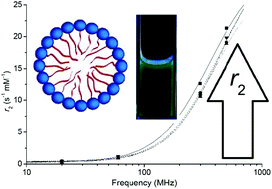Magnetofluorescent micelles incorporating DyIII–DOTA as potential bimodal agents for optical and high field magnetic resonance imaging†
Abstract
Dysprosium(III) was coordinated to four 1,4,7,10-tetraazacyclododecane-1,4,7,10-tetraacetic acid (DOTA) bisamide derivatives functionalized with amphiphilic p-dodecylaniline and p-tetradecylaniline in a differing cis- and trans-orientation. The complexes were assembled into mono-disperse micelles having size distribution maxima ranging from 10 to 15 nm and the magnetic and optical properties of the micelles were examined in detail. The micelles show characteristic Dy(III) emission with quantum yields reaching 0.8%. The transverse relaxivity r2 per Dy(III) ion at 500 MHz and 310 K reaches maximum values of ca. 20 s−1 mM−1 which is a large increase when compared to a value of 0.8 s−1 mM−1 observed for DyIII–DTPA. The micelles were stable in water when incubated at 37 °C for 1 week and showed no relaxivity decrease when measured in the presence of 4% (w/v) human serum albumin. The efficient T2 relaxation, especially at strong magnetic fields, is sustained by the high magnetic moment of the dysprosium(III) ion, the coordination of water molecules and long rotational correlation times.


 Please wait while we load your content...
Please wait while we load your content...